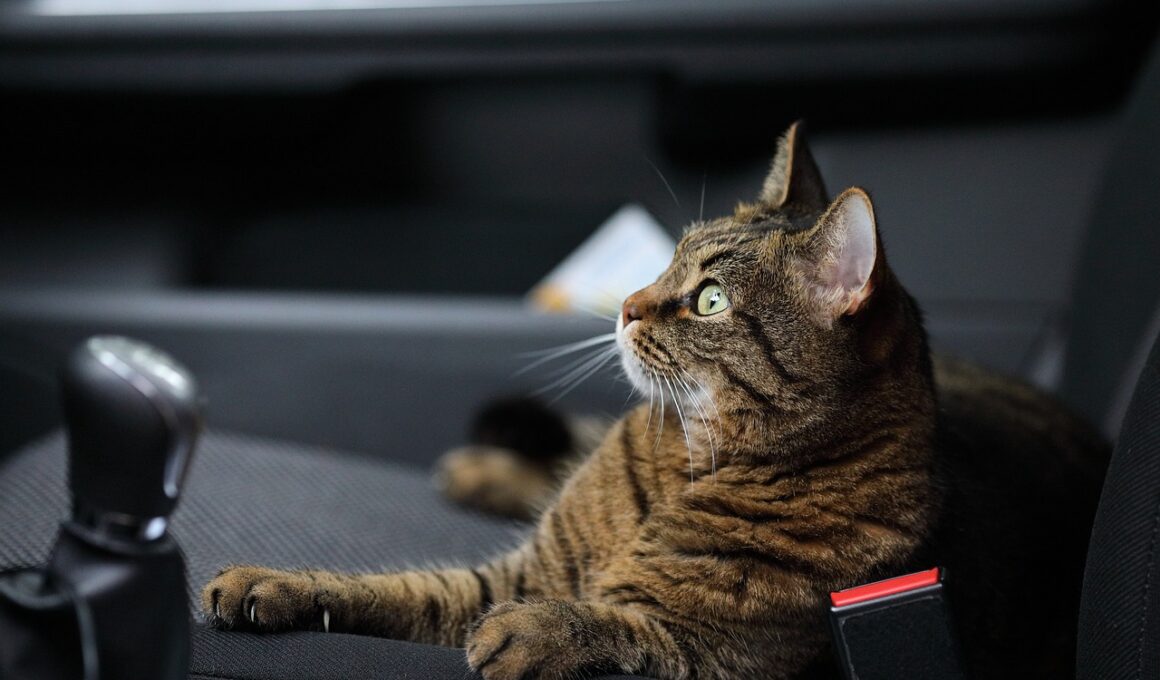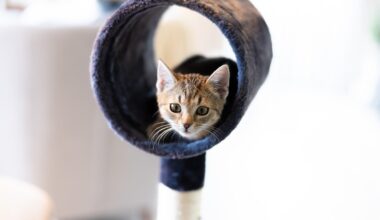Why Cats May Develop Anxiety Around Car Trips
Understanding feline behavior is essential when dealing with cat anxiety triggers, especially during car trips. Cats are creatures of habit and thrive on routine. When faced with experiences that disrupt their normal environment, such as car rides, they can become anxious or fearful. Several factors contribute to this anxiety. First, the confined space of a vehicle can be intimidating. Cats often prefer open spaces where they feel safe and in control. Additionally, the movement and noise of a car can overwhelm their sensitive ears and heightened sense of smell. These stimuli can induce stress, resulting in behaviors such as meowing or hiding when it’s time to travel. Movement sickness is another possible cause of anxiety, leading to discomfort during rides. Understanding these triggers can help cat owners alleviate their pets’ fears. It’s crucial to recognize the signs of anxiety in your cat, such as excessive grooming or aggression. By doing so, you can create a more comfortable environment for your cat during trips. Observing your feline’s reactions can provide valuable insights into their psychological well-being.
Considering the potential triggers, preparation is key when planning a trip with your cat. Feeding your feline in advance can help minimize nausea during the ride. Furthermore, familiar items like a blanket or toy can provide comfort. These items carry familiar scents, making the experience less intimidating. Using a cat carrier is strongly recommended for safety, but it should be well-acquainted beforehand to prevent distress. Insert cozy bedding inside the carrier to make it more inviting. Gradual desensitization can also assist; allow your cat to explore the carrier freely at home. Short car trips can serve as practice runs to acclimate them to longer journeys. If anxiety continues, consider consulting a veterinarian about potential medications. These can ease travel anxiety and make trips more enjoyable for both you and your cat. Explore different types of carriers; some offer more visibility and ventilation, which can help anxious kitties feel secure. Remember to monitor your cat throughout the journey; calming words or soothing music can have surprising effects on their anxiety levels.
Identifying Symptoms of Cat Anxiety
Observing your cat’s behavior during travel is essential to identify signs of anxiety. Signs may vary, with some common ones being excessive vocalization, panting, or hiding. Pay attention to your cat’s body language as well; crouching low, twitching tails, or flattened ears can indicate distress. If your cat becomes overly agitated, you may notice them trying to escape the carrier or even attempting to jump out of the vehicle. Understanding these signals can assist you in addressing their needs appropriately, elevating their comfort during trips. It’s imperative to remain calm yourself; cats can sense their owners’ emotions. If you exhibit anxiety or stress, your cat is likely to mirror those feelings. Keeping your voice steady and reassuring can help create a more positive atmosphere. Additionally, avoiding sudden movements while driving can assist in minimizing anxiety triggers. Ideally, schedule travel during quiet times, such as early mornings or late evenings, when road noise and traffic are less disruptive. Using a harness with a secure leash when the car is parked can also help prevent escape attempts.
Another potential avenue to explore when addressing car-related anxiety in your cat is behavior modification techniques. Progressive desensitization involves exposing your cat gradually to the stimuli associated with car trips. Start with sitting in the parked car while it is turned off. Over time, increase the duration of these practice sessions, adding in the engine noise and movement only when your cat appears comfortable. Consider using treats, toys, or interactive play as rewards for calm behavior. Positive reinforcement can greatly improve your cat’s association with car rides. After several successful sessions, you can progress to taking short, uneventful drives around the neighborhood. Ensure these drives are pleasant by providing treats or breaks to relieve their stress. It may take some time for your cat to feel comfortable in the car; however, with patience and perseverance, positive outcomes are achievable. If needed, consult with a veterinarian for additional behavioral therapies or alternative treatments. Collaborative efforts between owners and professionals can create a tailored approach to managing your cat’s anxiety effectively during car trips.
Creating a Comfortable Travel Environment
To enhance your cat’s travel experience, crafting a comfortable environment within the vehicle is crucial. Start by securing the cat carrier in a stable location during travel. Avoid placing it in the front seat due to the risk of airbags and distraction. Preferred placement is often the back seat, where movements can feel more stable and less alarming. Ensure there is adequate ventilation and remove any objects that could become projectiles during sudden stops. Maintaining a comfortable temperature within the car can also serve to reduce anxiety; avoid overly hot or cold conditions. Familiar items such as favorite blankets, toys, or even a piece of your clothing can help to soothe your pet. Cats find security in their own scent and items they associate with home. A calming pheromone spray can also be applied to the carrier before travel to promote relaxation. Additionally, consider investing in a calming collar or other products designed to alleviate anxiety during travel. Preparing ahead with these steps creates a peaceful atmosphere for both you and your cat, resulting in a more pleasant journey.
During the journey, it’s important to engage with your cat to maintain a positive tension-free atmosphere. Speaking softly to your cat can help reassure them that everything is alright. You might also consider soft music or nature sounds playing in the background to create an ambient environment. Avoid direct eye contact as this may be interpreted as a threat in feline communication. Instead, use gentle touches or allow them to rest their paws on your lap if they feel comfortable. Frequent stops can allow your cat to stretch and relieve some of their anxiety, provided it’s safe. When you stop, offer water or treats, and consider letting them explore a safe, enclosed area for a short time. Additionally, ensure they have quick access to a litter box during longer trips. Positive experiences during these breaks help your cat associate travel with enjoyable moments and reduce travel-related stress. Reviewing these steps can make each car trip significantly less overwhelming, fostering a positive bond between you and your furry companion.
Post-Trip Care and Adjustment
After arriving at your destination, it’s important to ensure your cat is settled comfortably. Allow their arrival to be a slow process, granting them time to explore the new environment at their own pace. Recognize that your cat may exhibit heightened anxiety or uncertainty in new surroundings; this is normal. Introduce them to different areas gradually, providing a sense of security by offering their familiar items, like blankets or toys, once again. Ensure a secure, quiet space where they can retreat if they feel overwhelmed. Offering a designated sleeping area can help to provide a sense of normalcy. It’s also useful to maintain regular routines regarding feeding and playtime. These familiar actions provide reassurance that their world remains stable despite changes in location. Keep an eye on your cat’s behavior after the trip; monitor for any signs of lingering anxiety or behavioral shifts. If these continue, consulting a veterinarian about potential therapies or additional techniques for easing their anxiety at home may be beneficial. Understanding and responding to your cat’s needs is critical for their emotional welfare, promoting overall happiness.
Ultimately, understanding and addressing cat anxiety, especially regarding car trips, is vital for keeping your feline happy and healthy. Knowledge of common triggers and acknowledgment of their boundaries are essential. Familiarizing your cat with their carrier and practicing short trips can significantly mitigate anxiety over time. Be attentive to their behavior, fostering a supportive environment through positive reinforcement techniques, calming products, or behavioral therapies. Most importantly, creating a safe and secure space for your cat during and after travel can enhance their comfort. Always remember that every cat is unique, and the journey to managing their anxiety often requires patience and understanding. By establishing strong trust and a positive bond, you can help your furry companion feel more secure during car rides. Ensuring the right approach fosters emotional well-being and enjoyment in your shared adventures. Maintaining open communication with your veterinarian provides an additional resource for effective solutions tailored to your feline’s specific needs. With commitment and time, you can transform car trips from a source of stress into an enriching experience for both you and your feline.


